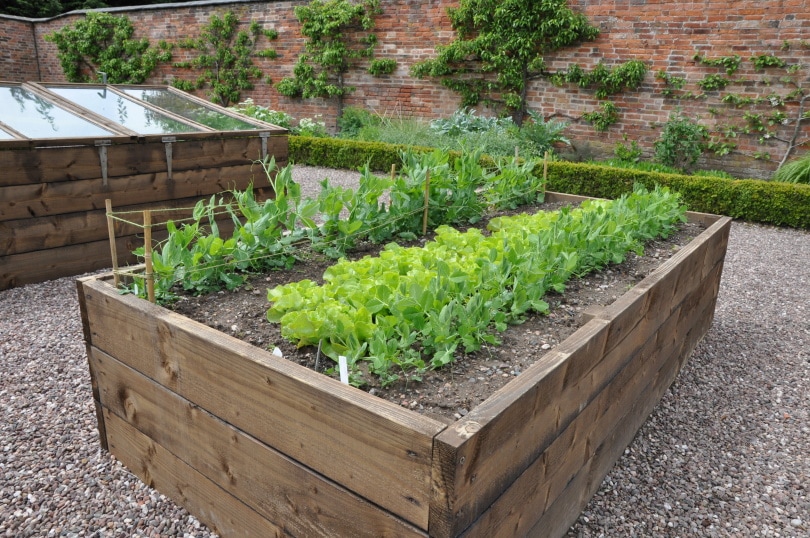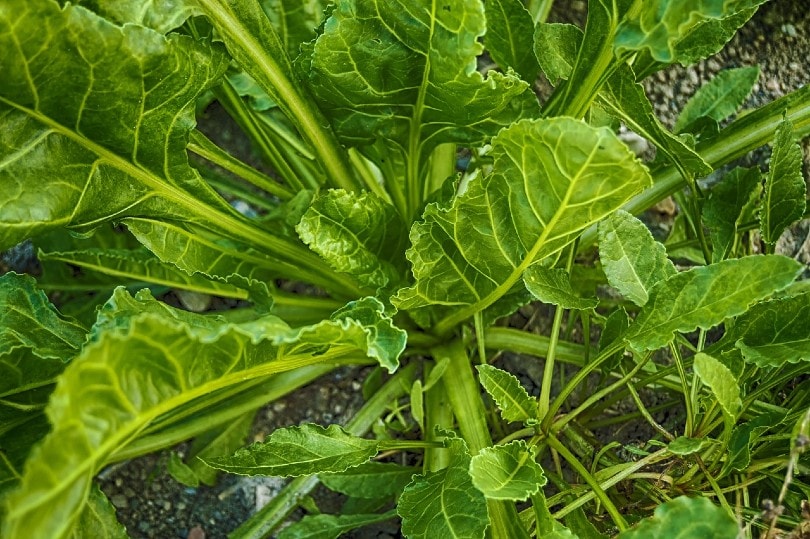10 Best Vegetables to Grow in Raised Beds (with Pictures)
-
Pete Ortiz
- Last updated:

Raised beds are an awesome way to grow vegetables. With increased soil control since it is less compact (unless you want it to be), you have a little more flexibility in your drainage options. The ability to grow your own vegetables with this level of soil control and drainage options is a great way to maximize the success of your garden.
Not only does growing vegetables at home help ease some of the grocery bills, but it is also extremely rewarding both mentally and physically. With so many benefits to growing vegetables in a raised bed, there’s really only 1 question left to answer; What are the best veggies to grow in your raised bed?
The Top 10 Best Vegetables to Grow in Raised Beds
1. Spinach

| Water | 1 – 1½” per week |
| Sun | Full sun/partial shade |
| Placement | Near lettuce, away from potatoes |
Spinach is a great plant for growing in your raised bed garden. You may want to give the spinach an early start in the season, however, this is a cool-loving plant. In fact, the spinach plant can grow in the springtime, late summer, fall and in some milder areas even can be planted in the winter!
Here’s something you probably didn’t know: In medieval times, green ink was made out of the pigment found in the leaves of spinach. Spinach is originally from Persia—now modern-day Iran and is one of the healthiest leafy greens going!
Not only is spinach chocked full of vitamins A, C, K1, calcium, and more, it is one of the most versatile leaves that you can cook with. Spinach leaves are delicious raw and cooked. Raw spinach goes great in a salad or smoothie, while staples like quiche wouldn’t be the same without cooked spinach. We’re starting off with a powerhouse plant!
2. Lettuce

| Water | 1 – 1 ½“ per week |
| Sun | Full sun/partial shade |
| Placement | In sun away from broccoli and cauliflower |
Lettuce is a leafy green just like spinach. Also, like spinach, it likes to be planted in cooler weather like spring or late summer. Lettuce is a great plant to have in the garden because it doesn’t take very long to yield, nor does it take up much space. The shallow roots and vertical growth pattern make it a compact plant, and it can even be planted over and in between potatoes.
Did you know that the average American eats about 30 lbs of lettuce per year? It’s a good thing that lettuce yields so much food! The reason so much lettuce gets eaten is likely due to its versatility:
Lettuce is washed and eaten raw on just about anything you can think of. From tacos to salads, there are a plethora of popular foods that call for lettuce, so you probably won’t find yourself throwing any away!
3. Tomatoes

| Water | 1–2” per week |
| Sun | Full sun |
| Placement | Near herbs, away from potatoes, broccoli, and cauliflower |
OK we know, we know—tomatoes are technically a fruit. We’re not splitting hairs here, and besides—tomatoes are a fantastic plant for a few reasons. These plants love the sun—the more the better. They should be placed in an area of your raised bed garden that gets a minimum of 6 hours per day to bear fruit, but again, more sun—more fruit.
There are an astonishing 10,000 varieties of tomatoes, worldwide! From tiny grape tomatoes, you can pop in your mouth like grapes, all the way up to the big juicy ones that you can slab onto a juicy hamburger! So, you can bet that they’re popular, versatile, and great to have in the garden!
4. Peas

| Water | 1” per week |
| Sun | Full sun/partial shade |
| Placement | Near beans, carrots, celery, away from onions |
Much like other green raised bed gardens, peas love cooler weather. They should be planted in early April through mid-May. They do like the sun, however, too much heat and they will start to fall off. Generally speaking, peas like to get about 5–6 hours of full sunlight per day.
Try not to let the soil completely dry out, as well. Peas will produce until the warmer weather pushes them out of production, but depending on your climate, you might be able to get another crop of tasty peas in the late summer. Not only are peas tasty, but they are also a very healthy vegetable.
Peas are very nutritious indeed—one serving contains as much vitamin C as a pair of big apples! Besides, there’s nothing as hearty as a bowl of pea soup or having them as a nice side with your carrots and mashed potatoes—delicious!
5. Green Beans

| Water | 1” per week |
| Sun | Full Sun |
| Placement | Near broccoli, cauliflower, carrots, and celery |
Green beans are a warm-weather crop that enjoys a good amount of sun—about 6–8 hours of full sunlight per day. These plants are like peas because although they love warm weather, the blossoms start to fall off when it gets too hot. That said, you don’t want to plant them too early either. Wait until there is no chance that the soil will freeze as cold, wet soil can make the seed rot.
Beans are delicious whether served raw and crunchy or cooked up. Fried up, spicy beans are a relatively healthy and delectable treat for those who don’t mind a little bit of heat! You won’t run out of ways to enjoy your harvest if you grow these in your raised bed garden.
6. Onions

| Water | 1” per week |
| Sun | Full sun |
| Placement | Near broccoli and kale, away from peas and beans |
Onions might not be the kind of plant that everybody likes to eat fresh out of the garden, but they are an important piece of many dishes! Onions are a cold-weather crop that should be planted in the spring—as soon as you find the soil is workable.
The size of the bulbs that they will yield depends on how much sun they get in the warmer season. So, if you want smaller bulbs, you’ll want plant them where they can get around 10–13 hours of sun. If want larger onions for chopping up, then you’re going to be shooting for an area that receives 16 hours of sun or more, if possible.
The more sun they get, the bigger the bulbs. Not everybody wants bigger onions—small onions or chalets are great for garnishing many dishes, with their more intense flavor.
7. Peppers

| Water | 1–2” per week |
| Sun | Full Sun |
| Placement | Near carrots and cucumbers, away from brassicas and fennel |
Peppers, as you might guess, enjoy warm weather. You may have to start them indoors, before transplanting them into your garden as they also need a long growing season. Start indoors, around 8 weeks before the last frost, and then keep them there until it starts to heat up in June. You don’t want to transplant them too early, so make sure to wait until the weather is really starting to warm up before you get them out there!
Did you know that a red bell pepper has the most vitamin C out of any piece of produce? As nutritious as peppers are, they are more likely popular because of their amazing taste and versatility. They go raw into Greek salads and get cooked on the grill next to steaks with equal splendor! Peppers might need some special conditions and patience to grow, but they are sure worth the wait!
8. Kale

| Water | 1–1 ½” per week |
| Sun | Full sun/partial shade |
| Placement | Near beets, celery, and cucumbers, away from peppers and potatoes |
Kale is a plant that does really well in the cold. They only need a few hours of sunlight a day, and though they may yield a little less in the partial sun during the warmer months, they are an incredibly useful plant. Now, too much sunlight and heat can cause kale leaves to wilt and die, but this is a fantastic plant for early spring and late summer into fall harvests.
This is a great leafy green for salad and is widely regarded as a superfood. For healthy eaters, it was really trendy to eat kale a few years ago and it was difficult to find a salad that didn’t call for kale! Trend or not, kale is a delicious leafy green that is packed full of nutrients.
9. Cucumbers

| Water | 1–2” per week |
| Sun | Full sun |
| Placement | Near carrots and onions, away from potatoes |
Who doesn’t love a delicious cucumber sandwich? Cucumber plants are a delicious addition to your raised bed garden. Much like peppers, they need warm soil to germinate. As such, it’s, like peppers, recommended to start growing them indoors and then transplant them into the garden when the soil gets properly warm in mid-June. Once you’ve got them planted, they grow quite rapidly.
You’ll want to keep the soil moist and ensure that the cucumber plants get about 6 hours of full sunlight per day. Since they make good companion plants and also go well in a greek salad together, you might like to try keeping peppers and cucumbers together!
10. Carrots

| Water | 1” per week |
| Sun | Full sun/ partial shade |
| Placement | Near beans, lettuce, and onions, away from potatoes |
Being a root vegetable, carrots do well when they are planted in the early spring and late fall. They take about 70–80 days before they can be harvested, so they aren’t the fastest plant, but those fresh sweet carrots sure are worth the wait. Carrots like to have about 5 hours of direct sunlight per day, but they will still do well in partial shade situations.
One interesting thing about carrots is that they can be left in the ground over the course of the winter. In fact, the sweetness concentrates, so you end up with a really tasty, fresh carrot, harvested in the middle of winter! That’s a pretty resilient vegetable–and they’re delicious too!
Conclusion
Raised bed gardens are a fantastic way to enjoy the satisfaction that comes with growing your own vegetables. There is something empowering about producing your own food with nothing but what mother nature gives us. We hope this guide will help give you some insight into how you layout your garden and when to plant what—where! We hope you enjoy using this information and have a great harvest!
- See Also: 10 Best Vegetables to Grow in Colorado (With Pictures)
- See Also: What is the Best Wood for Raised Garden Beds? (With Pictures)
Featured Image Credit: Linda George, Shutterstock
Contents


